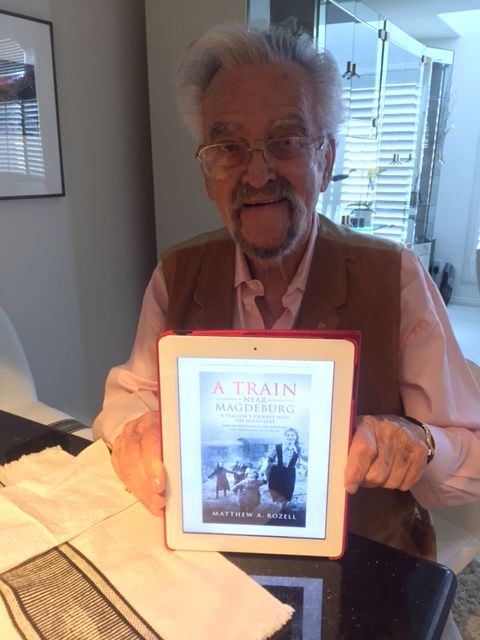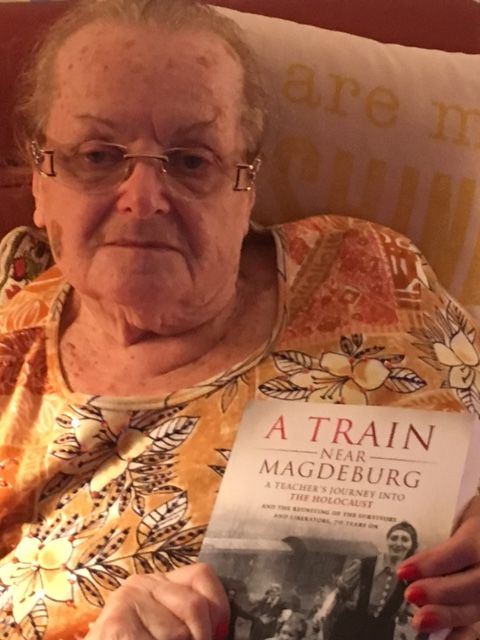The new book is getting some early good reviews.
~”A ‘Must-Read’. A real tribute to the survivors and liberators. I could not put this book down. Highly recommended as a required reading for anyone taking or teaching Holocaust History. Suited for high school / college / adult education settings.”– Rabbi Justin Schwartz
~”If you have any trepidation about reading a book on the Holocaust, this review is for you. [Matthew Rozell] masterfully conveys the individual stories of those featured in the book in a manner that does not leave the reader with a sense of despair, but rather a sense of purpose.”-Cassandra
~”One might think why this book should be read: there are so many books about the Holocaust and yes, we know it happened. But in no book that I have read up to this day, the story comes to life in such a personal way. How the lives of innocent people were impacted, what they went through and how they were formed by their experience. By zooming in on this particular event, you get to know what it was like – not only for the victims, but also for their liberators. Or, as quoted in the book: It is important to have the past in front of you – not in the ‘rearview’ as one moves forward.” -Amazon customer
~”As an Emmy award-winning documentary filmmaker I am always looking for good stories; stories that move the heart as well as the mind. This book does that in spades. From the first page to the last it rivets you to the passion of the author’s journey and to the story of the people of whom he writes about. This story is a shining example of the good that people can do to help their fellow man. It is a story of a man who has followed his heart and mind to accomplish great things for others.”-Michael J. Edwards, Searching For Augusta (PBS)
*
Below are two more satisfied customers, and excerpts from the book, which features their testimony as well as the testimony of more than 30 other survivors and over a dozen liberators.

kurt-bronner
Kurt Bronner
Kurt Bronner (Chapter 1) was from Hungary. He spent a lengthy amount of time recuperating in Sweden following the war, and later came to the United States. He is a retired graphic designer currently living near Los Angeles.
Two weeks after we arrived, my dad started to cough. One morning, I heard men reciting prayers, and someone said to me, ‘I’m sorry. Your father is dead.’ Eighteen years old, I didn’t know; I never faced death before. Then in the morning they took the bodies out; I tried to follow my dad’s cart, being taken to the so-called cemetery—[but I could not find him, there were so many bodies]. And a week later, I saw my mother through the barbed wire; we started talking, she wanted to know how dad is, and I lied and I said, ‘He’s fine, he’s sleeping’—I didn’t want to burden her with the bad news. [Pause] And then a German woman guard started to beat my mother. [Pause] You are on this side of the fence, and on the other side is your mother, and there is nothing you can do. And that is the last time that I saw my mother; I don’t know what happened to her; I tried to find out, and all they could tell me was, fifteen thousand women died without any names.
*

jean-lazinger
Jean Weinstock Lazinger
Sol Lazinger (Chapter 10) was the son of Polish Jewish immigrants. He was decorated with two Purple Hearts and the Silver Star. He was evacuated after being wounded in Belgium. He married Jean Weinstock Lazinger (Chapter 1) in 1950. Jean was from Poland. Until they learned of the author’s first reunion in 2007 through the news media, neither realized that it was Sol’s division which had liberated Jean’s train. Sol passed away in 2012 at the age of 87; Jean lives in Philadelphia.
We went to Bergen–Belsen in July 1943. And we were the first civilians in that camp. We used to get a slice of bread and coffee in the morning. And we used to get this turnip soup. Sometimes we used to get spinach soup with white worms on top. And there were a couple doctors there, they said, ‘You better eat it, because it’s protein.’ But I was unable to do that.
They separated the men from the women, but we were able to see each other through the day. After 5:00 the men had to be in their barracks and the women had to be in the women’s barracks. We had bunk beds… but, as they were bringing other people from different [places], our camp got smaller and smaller. We were divided by the wires and we were able to speak to the people on the other side, and I remember exactly when the train came from Holland. There was hunger, there was cold, then they brought the Hungarian Jewish people… it was right in the next barrack from us, we had a hard time because they spoke a different language than us, but some people spoke German, so we were able to communicate a little bit.
Sol Lazinger
I was a rifleman. I was young. We [look back, and] try to compare ourselves after sixteen weeks of basic training—and we went into combat fighting German soldiers who had a minimum of five years’ worth of army experience. It was not the easiest thing in the world, but we did the best we could.
I fought my way through France. I was very lucky because I was in combat for most of the time. I went through many battles all through France, Belgium, and Holland; and when the big officers came around, they used to tap me and say, ‘Oh, you’re still here?’
When we broke through the Siegfried Line and attacked, many of my friends were killed. One fellow by the name of Ben Shelsky, was a replacement soldier [like me]; he went over the Siegfried Line, too. He got a telegram from the Red Cross that said his wife gave birth to his child. The next morning a sniper killed him; the telegram telling him that he became a father was sticking out of his pocket.
So we went across the Siegfried Line and went to a town by the name of Lubeck, Germany. After the first day there, I was wounded in street fighting; I spent on and off almost two years in the hospital—I had most of my left ankle blown out by machine gun bullets.
When someone lost a friend, we sort of tried to stick together even though we were all from different parts of the country. And you get sort of down with everything, but as I say, you know, we did the best we could, but it was an uphill battle fighting against the soldiers who were trained for longer periods of time. But I think the American boys did very well.
*
On Liberation:
Kurt Bronner
What I remember is that suddenly the doors of the cattle car were opened, and we were out there, hearing the machine guns, and the gunfire, very close by. We didn’t have any food, we didn’t have any water—but we were alive! We saw the German guards running; and we saw them taking their clothes off and changing into civilian clothes… and we were waiting. And suddenly we saw some convertibles, and some tanks on the road above and looking up from the small valley, and seeing the white stars on the jeeps—we thought they were Russians, you know— ‘stars’. Then one soldier came and started to speak in English. Very few of us spoke English, and he said in Yiddish, ‘I am a Jew, too’—excuse me [puts hand over heart, gets emotional]—memories coming back [pauses]… we were given our lives back. We were taken to the Hillersleben village, and I remember one of the American soldiers came by, and pointed us to a room. And twenty, twenty-five of us went into the room—and the first English expression I learned was, ‘One only!’ [Laughter] And it was a room for one person!
I go to schools and talk to the students, and one of them asked me, ‘When did you know that you were free?’ And I tell them, when I went to the bathroom, and closed the door, by myself, alone, in privacy; that is when I knew I was free; [I had my dignity]. And after the DDT, the new clothes, the white sheets on a bed-we felt free.*
* DDT– insecticide used later in WWII to control malaria and typhus among civilians and troops. A white powder was generally sprayed on the subject; it was banned for agricultural use in the USA in 1972 as a threat to wildlife.

